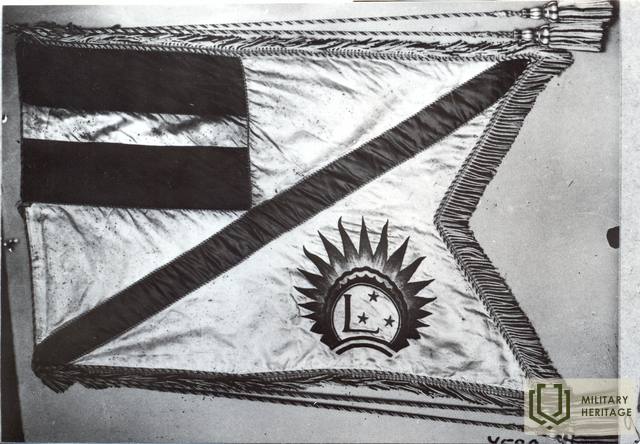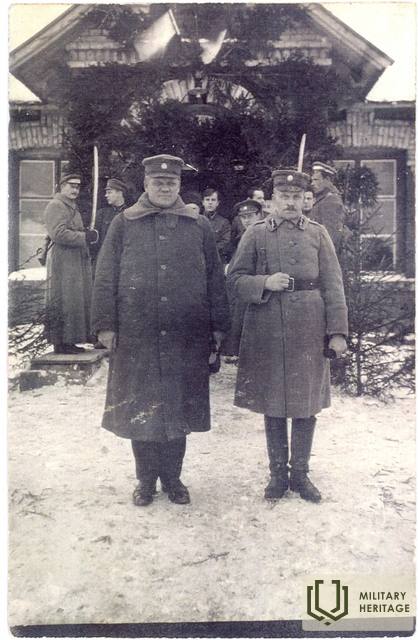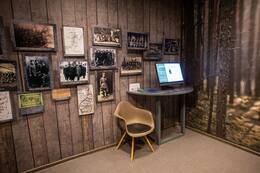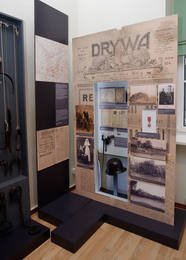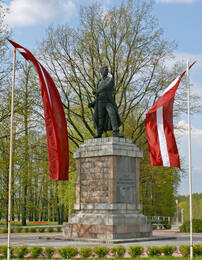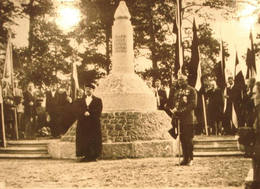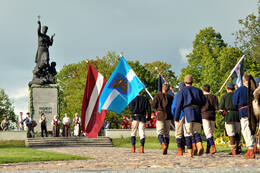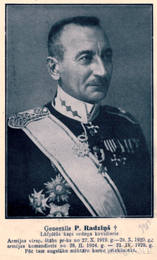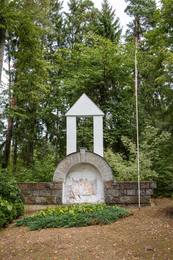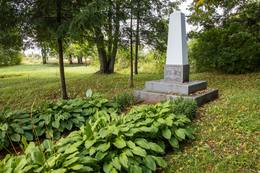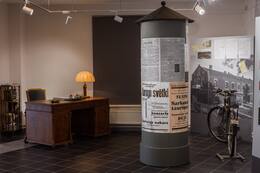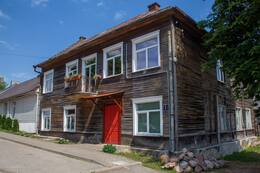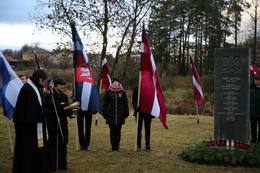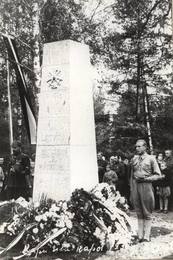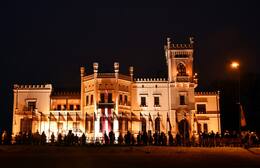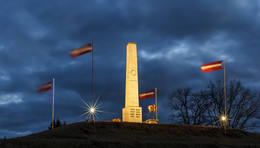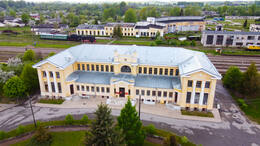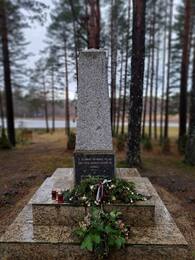Liberation of Latgale from the Bolsheviks
I Wars of Independence
After the victory over Pavel Bermont's forces, the Latvian government decided on an operation to liberate Latgale, which needed the support of neighboring countries. After unsuccessful talks with Lithuania at the end of December, the Supreme Command agreed to co-operate with the Polish army. On January 3, 1920, Polish and Latvian forces attacked South Latgale, liberating Daugavpils, and on January 9, the Latvian army liberated Latgale until the beginning of February.
At the time of the liberation of Latgale, the Commander-in-Chief of the Latvian Army was General Jānis Balodis, and the Chief of Staff of the Commander-in-Chief was Colonel Pēteris Radziņš. The Daugavpils capture operation was led by Polish General Edward Ridge-Smigli. The liberation of Rēzekne and the central part of Latgale was led by the commander of the Kurzeme division, Lieutenant Colonel Jānis Puriņš. The liberation operation in northern Latgale was led by the headquarters of the Latgale Division in Vecgulbene, led by Colonel Krišjānis Berķis.
At the same time, at the beginning of January 1920, a delegation of the Latvian Red Cross went to Moscow to conclude the ceasefire, which was signed on January 30 (entered into force on February 1). Peace talks began in Moscow on April 16, but continued in Riga over the summer, depending on events on the Soviet-Polish front. The peace treaty was signed in Riga on August 11, 1920.
In April and May 1920, the newly formed Zemgale division joined the army on the Latgale front, while in the middle of April the Polish army left Latvia, remaining only in Daugavpils. It was forced to leave the city in early July as a result of the Red Army's offensive. Then Latvian forces took over part of the present-day town of Grīva (then a separate town on the left bank of the Daugava) and six parishes of Ilūkste district, which had been declared to belong to Poland. Already after the peace was concluded in the beginning of September 1920, the 12th Bauska Infantry Regiment and other units repressed Lithuanian army units in the Subate district, but in October the Latvian army occupied the last parishes of Ilukste district, which were left by the Lithuanian army.
More information sources
Eric Jacobson. Latvian War of Independence. The struggle of the Provisional Government of Latvia and its armed forces to ensure the independence of Latvia on November 18, 1918 - August 11, 1920. - National Encyclopedia: https://enciklopedija.lv/skirklis/22216-Latvijas-Neatkar%C4%ABbas-kar%C5%A1
Juris Ciganovs. The liberation of Latgale in 1920 marked the end of Latvia's War of Independence. SARGS.LV, 03.01.2020. https://www.sargs.lv/lv/latvijas-neatkaribas-kars/2020-01-03/latgales-atbrivosana-1920-gada-iezimeja-latvijas-neatkaribas
Liberation of Latgale. Wikipedia. https://en.wikipedia.org/wiki/Latgales_atbr%C4%ABvo%C5%A1ana
North Latgale liberation operation. Wikipedia. https://en.wikipedia.org/wiki/Zieme%C4%BClatgales_atbr%C4%ABvo%C5%A1anas_oper%C4%81cija
Связанная хронология
Связанные объекты
Exhibition "Ziemeļlatgale in the freedom struggle" in Balvu County Museum
The exhibition allows you to look into the history of Latvian Independence from the point of view of Northern Latgale. What is the contribution of the people of our side, how did our grandfathers get involved in the fight for the common cause of Latvia, what are their fates, how is their memory preserved? Answers to these and other questions can be found in Latvian, Russian and English.
The Northern Latgale liberation operation, also called the Viļakas-Jaunlatgale capture operation, was part of the Latgale liberation attack operation carried out by the Latvian armed forces during the Latvian freedom struggle. Its purpose was to occupy the northern part of Latgale and cut the Pskov-Daugavpils railway line in order to prevent the arrival of additional units of Soviet Russian troops from the Estonian front and from inside Russia. The most important battles took place between January 9 and 20, 1920, when control over the railway line from Pitalova (Abrene) to Kārsava was gained.
Preiļi Museum of History and Applied Art exhibition "Museum stories for Latvia"
It is located in the premises of the Preiļi Cultural Center.
Preiļi Museum of History and Applied Art (PVLMM) exhibition "Museum stories for Latvia" about the First World War, the War of Independence and the Second World War can be viewed.
The "Story of Drywys" section of the exhibition "Museum Stories for Latvia" (opened in 2018) of the Museum of Preiļi History and Applied Arts is dedicated to the First World War, the War of Independence and the liberation of Latgale, as well as to the knights of the Lāčplešana War Order. The exhibition section "The story of the flag" tells about the difficult events of the Second World War period, during which the people of Preila were affected by deportations, the Holocaust, involvement in the military units of the warring parties, and after the war - in the ranks of national partisans. The "Righteous Among the Nations" medal awarded to Vladislav Vuškānas, the savior of the Jews from Preiliat, can also be viewed.
Upon prior application, a tour is available in Russian and English.
Monument to the fallen soldiers of the Latgale partisan regiment 1919 - 1920
A monument dedicated to the Latgale partisan regiment.
In the history of the War of Independence of Latvia (1919-1920), the Latgale partisan regiment, whose cradle was once in the territory of the former Balvi district, was formed from the "green" regiments already at the end of 1918.
The monument was opened for the first time on August 14, 1938, with the participation of General Jānis Balodis. The author of the monument is the artist Kārlis Jansons.
In 1940, the communists destroyed the monument, after the establishment of Soviet power, the executive committee of Abrene district decided to demolish the monument in the spring of 1941, but the image of the partisan was buried in the courtyard of the Balva militia. During the German era, the monument was restored, but when the Red Army returned, the monument was torn down a second time, taken away and destroyed. When Latvia regained its national independence, the people of Balveni collected donations for the restoration of the Latgale partisan monument. On November 11, 1993, the restored monument of Andrej Jansons, the son of the artist Kārļis Jansons, was unveiled at Balvos.
A monument to the soldiers who died in the battles for the liberation of Latvia in Jaškov
The road section Viļaka – Vientuļi (P35) is on the left side of the road, near the chapel of the Jaškova grave.
Monument to Latvian and Estonian soldiers who died in the War of Independence.
The monument created by the sculptor Kārlis Zemdega in 1920 in memory of the soldiers who fell in the Freedom Struggle in Jaškov was first unveiled on September 22, 1935 at the graves of the Viļaka brothers established in 1929.
The struggle for freedom against the Red Army in Viļakas district began with the attack of the Latvian army and the Latgale partisan regiment on January 9, 1920. Estonian soldiers also participated in it. Viļak was liberated already on January 9, but the fighting to the east of it continued for several more days. Both before and after the liberation of Vilakas, the fallen soldiers were buried in different places known to local residents. As the state of Latvia stabilized, Viļakas began to think about setting up joint graves of brothers. Already from November 18, 1923, after a solemn service in the Catholic church, held by dean P.Apšinīks, a large procession went to the newly formed burial place of the brothers on the hill, in the so-called Jaškov - in the immediate vicinity of Viļaka. Soon, the foundation of the monument was built, the collection of donations for the monument began. Identifying the graves of the fallen soldiers took time, only on November 3, 1929, the reburial took place in the future graves of the brothers. The 31 Latvian and 14 Estonian soldiers who fell in the vicinity of Viļakas were buried in them. In 1935, the monument was ready and on September 22, it was solemnly consecrated.
In the pre-war years of Latvia's independence, all important national events in Viļaka parish were connected with the brothers' graves and this monument.
The monument was destroyed during the post-war years of Soviet rule, but its granite parts, although damaged, were preserved. The monument was restored on November 11, 1990 - Lāčpleš Day.
"United Latvia" monument
The monument to the liberation of Latgale (popularly known as "Latgales Māra") is the most recognizable symbol of Rēzekne. Dedicated in 1920 to the participants of the Latvian freedom struggle and embodies the idea of the freedom and unity of the Latvian state. The monument was opened in 1939. (artist L. Tomasickis, sculptor K. Jansons), its bronze sculptural composition consists of: a chain puller, symbolizing the freedom won by the heroic sons of Latgale over foreign powers, a kneeling girl next to him crowns the liberator with a wreath of oak leaves, and above both figures - a national daughter who in his hand he holds a raised golden cross - symbolizing faith and satisfaction for regained freedom.
1940 the monument was demolished in 1943 it was restored, but in 1950 the ruling power destroyed it. In 1992, thanks to the funds donated by the people, the monument rose again in all its glory on the hill of Liberation Alley (sculptor A. Jansons).
Memorial place of General Pēteris Radziņš
Located in Valka parish, driving on the road Valka - Rūjiena (P22) 4 kilometers, to the right, following the signs.
Pēteris Radziņš was born on May 2, 1880 in Lugavis Parish, Jaunvīndedze. Studied at Lugaži Parish School, Valka City School and Valka Nelson Real School. Joined the Russian army as a volunteer. In the autumn of 1919, he returned to Latvia and on October 27 was appointed Chief of Staff of the Commander-in-Chief of the Army, assuming this position at a time when the Bermontians were threatening Riga. As the chief of staff, he has led all the battles of Riga, Zemgale and Latgale. Promoted to General on February 5, 1920.
Today, a memorial stone dedicated to General Pēteris Radziņš (1880 - 1930) can be seen near the family house.
On November 11, 2017, a memorial plaque to Pēteris Radziņš was unveiled in Riga, at the corner of the Daugava gate.
Video: Memorial event of General P. Radziņš in Riga Brothers Cemetery in 2019
Video: On May 2, 2019, on the 139th birthday of General Pēteris Radziņš, a commemoration event took place on the embankment of November 11, near the Presidential Palace, covering the memorial plaque to the guard of honor and those interested.
The exposition of Valka Local History Museum “Valka - the cradle of Latvia's independence” also reflects the life and work of General Pēteris Radziņš.
In addition to the traditional ways of displaying the collection, the exhibition uses interactive multimedia solutions. Information and annotations translated into Estonian and English.
Monument to the soldiers of the 1st Liepaja Infantry Regiment at the battlefield of 1919
Located in Madona district, Murmastiene parish, Meža Strodu village, 6 km from Varakļāni.
A monument to the Freedom Fights can be seen at the battlefield of the 1st Liepaja Infantry Regiment, where in 1919 they fought against the "red" army. Not far from this place, Aleksandrs Lakstīgala, a countryman, was seriously wounded in the battle. A dead man was found near his home. Therefore, the location of this monument was chosen.
On August 16, 1936, the granite Victory Monument (it was called in the press of that time) was unveiled to commemorate the Freedom Fights, engraved with the words: “1. every corner of our homeland - so now ours. ” It was installed by the leadership of the Rēzekne Guard Regiment, consecrated by the senior pastor of the Rēzekne Guard Regiment Vincents Tomašūnas with the local parish dean Kalinka. The opening debts were accepted by Žanis Bach, the commander of the Zemgale division and a knight of the Lāčplēsis Order. In 1950, it was demolished and destroyed. On November 16, 1996, the restored monument was inaugurated, also in honor of the 78th anniversary of the proclamation of the Republic of Latvia.
Exposition "Latvian Army in Pļaviņas in the 20th Century"
Located at Odzienas Street 2, Pļaviņas.
The permanent exposition "Latvian Army in Pļaviņas in the 20th Century" can be seen.
The building in Pļaviņas, Odzienas Street 2, has a long history - from the time when Stukmaņi wholesaler Hugo Apeltofts started active economic activity in it, thus promoting the development of Pļaviņas city, until the headquarters of the Latvian Eastern Front was established here during the War of Independence. In 1919, the activities of Latvian army units against the Red Army in Latgale were commanded directly from Pļaviņas.
In 1934, a memorial plaque was unveiled near this house with the inscription: "In 1919, the headquarters of the Eastern Front was located in this house, and here General Jānis Balodis took over the command of the Latvian National Army." It was removed and destroyed by the Soviets in 1940, but on June 16, 1990, with the support of the LNNK Plavinas branch, it was restored.
Now, next to the former headquarters building, there is a memorial stall dedicated to 15 cavalry of the Lāčplēsis Military Order born in Pļaviņas region. In Pļaviņas, as well as provides an insight into the life stories of the Knights of the Lāčplēsis War Order.
Not far from the exposition building is the Latgale Division headquarters building, which was built in 1913 by Count Teodors Medems as a Stukmaņi liqueur factory. In 1919 it was taken over by the regime of P. Stučka, where it had also established a prison. After the expulsion of the Bolsheviks, in 1925 the building was taken over by the Latvian Army, which housed the headquarters of the Latgale Division. 10 generals and other officers of the Latvian Army spent their military careers in this building. In 1940, the building was taken over by the Red Army. In the post-war years, it housed a school as well as a municipality. Around 1970, the building was started to be used by the production association "Rīgas Apīrsbs".
Visits to the exhibition must be booked in advance by calling T. 28442692.
Exposition “Abrene Rooms”
The exhibit ‘Abrene Rooms’ is located near the city centre of Viļaka. It covers the period from 1920 to 1960 when Viļaka was part of Jaunlatgale, Abrene district, and became the centre of Viļaka district and Abrene municipality. The exhibit is located in the building with the most interesting and diverse history in Viļaka. Initially located on the old Marienhausen Market Square, it later housed apartments, offices and various shops and, during World War II, the Latvian Self-Defence headquarters, the Gestapo and also the Cheka. The exhibit features items from the national partisan camp in the Stompaki Bog, which are related to the national partisan movement in the Latgale region, as well as documents and photos associated with the War of Independence. With a guided tour booked in advance, the owner, Dzintars Dvinskis, will present the testimonies available in the exhibit.
In 2023, an exhibition for military heritage in Northern Latgale was created.
Piemiņas stēla Lāčplēša kara ordeņa kavalieriem
Atrodas līdzās Viļakas Jēzus Sirds Romas Katoļu baznīcai.
Piemiņas stēla Lāčplēša kara ordeņa kavalieriem Viļakas novadā atklāta 2017.gada 11.novembrī. 28 Lāčplēša Kara ordeņa kavalieru likteņi ir saistīti ar Viļakas novada vārdu.
Granīta stēla tapusi Latvijas valsts simtgadei veltītā projekta “Atceries Lāčplēšus” ietvaros. Godinot Latvijas Brīvības cīņās kritušos karavīrus, visā Latvijā tiks uzstādītas vienota parauga piemiņas stēlas. Projekta iniciators ir Jaunsardzes un informācijas centrs.
Pieci Lāčplēša kara ordeņa kavalieri, kuru vārdi iegravēti piemiņas stēlā, pēc Brīvības cīņu noslēguma dzīvoja tagadējā Viļakas novada teritorijā:
– Jānis Kuļšs bija jaunsaimnieks Šķilbēnu pagasta Apsīšos,
– Aleksejs Ļubimovs (Lavrentjevs) dzīvoja Šķilbēnu pagasta Fortepjanovas fermā, vēlāk Viļakā,
– Teodors Mende saimniekoja viņam piešķirtajā saimniecībā un bija mežsargs Žīguru pagasta Katlešu ciemā,
– Eduards Tenisons dzīvoja Vecumu stacijā, vēlāk dzīvoja Čabatrovas ciemā un strādāja p/s “Viļaka”,
– Jānis Burmeistars pēc 1928. g. kādu laiku dzīvojis Šķilbēnu pagastā.
Brāļu kapi Viļakas novadā ir atdusas vieta 45 karavīriem, kuri 1920. gadā atdeva savas dzīvības, aizstāvot Latviju no lieliniekiem. 9. janvāris bija diena, kad uzbrukumi sākās Ziemeļlatgalē, un, neskatoties uz toreiz esošajiem sarežģītajiem laikapstākļiem, tajā pašā dienā arī tika atbrīvota Viļaka.
Latgales atbrīvošanas kaujās Viļakas novadā plecu pie pleca kopā ar Latvijas armijas karavīriem un partizāniem pret Sarkano armiju cīnījās arī Igaunijas karavīri. Daudzi no viņiem atdeva savu dzīvību par brīvu Latviju.
Alūksnes muzejs
Atrodas Alūksnes Jaunās pils telpās.
Alūksnes muzeja piedāvājumā militārais mantojums atspoguļojas pamatekspozīcijās: "Totalitārajā režīmā cietušo piemiņas istaba", kas veidota represiju atcerei un atklāj Alūksnes novada iedzīvotāju likteņgaitas Sibīrijā un Tālajos Austrumos, un Alūksnes vēstures ekspozīcijā "Laikmetu mielasts", kur satiekas laika periodi no aizvēstures līdz mūsdienām. Atsevišķa nodaļa ekspozīcijā veltīta 7. Siguldas kājnieku pulka ieguldījumam militārajā jomā, kultūras un sabiedriskajā dzīvē.
7. Siguldas kājnieku pulks no 1919. gada 20. aprīļa sācis formēties kā 3. Jelgavas kājnieku pulks, no 25. augusta nosaukums – 7. Siguldas kājnieku pulks. Siguldas kājnieku pulks piedalījās kaujās pret Bermontu, tad 1920. gada 5. janvārī ieradās Latgales frontē, kur piedalījās daudzās kaujās, tajā skaitā pie Katlešiem, Vecumu un Purvmalas stacijām, kā arī Jaunlatgales un Augšpils atbrīvošanā. Pēc miera līguma noslēgšanas pulks apsargāja robežu no Rītupes stacijas līdz Igaunijas robežai. Brīvības cīņās krituši 68 karavīri, ar Lāčplēša Kara ordeni apbalvoti 85 karavīri.
Alūksnes muzejs atrodas Valsts nozīmes arhitektūras piemineklī - Alūksnes Jaunajā pilī, kas celta neogotikas stilā 19.gs. beigās. Latvijas pirmās brīvvalsts laikā Alūksnes Jaunajā pilī bija izvietots 7.Siguldas kājnieku pulks.
Pēc Otrā pasaules kara pili pārņēma padomju drošības iestādes, bet no 1950-to gadu beigām pilī darbojušās dažādas kultūras iestādes – izpildkomitejas Kultūras un Kinofikācijas nodaļa, pionieru nams, bibliotēka, bērnu bibliotēka, kinoteātris un muzejs.
Piemineklis Latvijas Neatkarības karā kritušajiem 7. Siguldas kājnieku pulka karavīriem
Atrodas Alūksnes ezera krastā, Pleskavas ielas (Kolberģa ceļa) malā.
1923. gada 22. jūnijā Latvijas Valsts prezidents Jānis Čakste atklāja pieminekli kritušajiem 7. Siguldas kājnieku pulka karavīriem. Piemineklis veidots pēc mākslinieka Jūlija Miesnieka meta.
Pulka karavīri labiekārtoja un uzturēja arī pieminekļa apkārtni. Pie pieminekļa karavīri pulcējās pulka gada svētku priekšvakarā, kad iededzināja svēto uguni, kā arī pulka gada dienā pēc parādes un aizlūguma Garnizona kapos.
1940./1941. gadā boļševiki plāksni noņēma un iznīcināja, bet pašu pieminekli nojauca 1953. gadā un tā akmeņus iemūrēja kazarmu mājas stūra pamatos.
Sākoties Atmodai, 1989. gada rudenī tika sakopta nopostītā pieminekļa apkārtne, kas tolaik vēl atradās PSRS okupācijas karaspēka daļas teritorijā. Pieminekļa kādreizējā atrašanās vietā 11. novembrī tika atklāta pagaidu granīta piemiņas zīme, kurā iekalts teksts: "Šajā vietā tiks atjaunots 7.Siguldas kājinieku pulka piemineklis 11.XI 1989."
Pateicoties Alūksnes Brāļu kapu komitejas nodaļas vadītāja U. Veldres iniciatīvai, tika uzsāki pieminekļa atjaunošanas darbi un 2009. gada 16. oktobrī atklāja atjaunoto pieminekli.
Atšķirībā no pieminekļa oriģināla, uz obeliska pulka krūšu nozīmes vietā tika izveidots krusts. Abus pieminekļa ciļņus kalis tēlnieks Ainārs Zelčs. Atjaunotajam piemineklim tika izmantoti gan daļa no 22 oriģinālā obeliska blokiem, kas tika atrasti Nacionālo bruņoto spēku Kājnieku skolas teritorijā, gan jaunizgatavotie bloki.
2019. gada 20. jūnijā 7. Siguldas kājnieku pulka simtgades pasākumu ietvaros pieminekļa kalna pakājē tika atklāta pulka pieminekļa piemiņas vieta un granīta piemiņas plāksne vienības kritušajiem karavīriem, kurā iekalts teksts: “Jūsu stiprais gars vienmēr ierindā ar mums…”. Piemiņas vieta iekārtota par nacionālo bruņoto spēku Kājnieku skolas personāla saziedotajiem līdzekļiem.
Gulbene Railway Station
The Gulbene Railway Station is located in the city of Gulbene. During World War I, in 1916 to 1917, the narrow-gauge railway line to Pļaviņas was reconstructed to 1,524 mm width to ensure that it can serve as a connection to the Rīga-Daugavpils line. In addition, a railway line to Ieriķi and to Sita was constructed, thereby establishing a connection with Pytalovo. As a result, Gulbene became a railway hub. The current station building by architect Pēteris Feders was constructed in 1926. During the War of Independence, on 31 May 1919, when Gulbene was liberated from the Bolsheviks, the 1st (4th) Valmiera Infantry Regiment collected a significant number of war trophies here. On 14 June 1941, both civilians and Latvian Army officers arrested in the Litene Summer Camp were deported from the Gulbene Railway Station. As a key hub, it was bombed in the spring of 1944. After the war, it was restored to its original form. An educational and interactive centre named ‘Railway and Steam’ was opened in 2018. Next to the Gulbene station is the company SIA Gulbenes – Alūksnes bānītis, which offers interactive lessons and tours. Visitors have access to the station building and platform, a memorial plaque and a monument to the repressed ones by sculptor Indulis Ranka.
Arendole Manor
Arendole Manor was first mentioned in historical sources in the 16th century. Over time, its owner families changed several times: Grappenbruck, Līdinghausen-Wulf, Platter-Sieberg. The manor acquired its current appearance during the next reconstruction from 1895 to 1901.
During World War I, the 18th-century wooden chapel in the manor park burned down, and much of the manor's inventory was looted.
Based on the agrarian reform law, the manor was expropriated on January 14, 1921 and transferred to the Kalupe parish board. The manor house was renovated, and in 1925 a primary school and an orphanage were established there. A boarding house for war invalids was set up in the servants' house. The school and the home for the disabled continued to operate until 1975. After that, the manor was inhabited for 20 years, but was not destroyed.
In 1995, the Arendole Manor House was purchased by private owners and its revival began. Since 2002, the “Es Latgalei” association has been operating in the manor. Renovation and restoration work has been carried out in the grain warehouse, the houses of the lords and servants, and the remaining walls of the horse stable have been preserved.
In the manor, you can see the renovated premises, as well as the largest collection of ancient objects in Latgale, and get acquainted with information about various historical events in Latgale in the 20th century. A separate exhibition is dedicated to the former Kalupe parish policeman Jānis Babris (1904–1982), who on June 14, 1941 resisted the deportation operational group: he shot the militiaman Slica and wounded the communist party agent Jozāns.
At Arendole Manor, it is possible to stay overnight, rent out rooms for various events, and relax in the open air.
Monument to the Latvian Freedom Struggles at the site of the battles of the 3rd Jelgava Infantry Regiment
Monument to the 3rd Jelgava Infantry Regiment's January 16, 1920, freedom struggle in Latgale. With the inscription: “The place of the 3rd Jelgava Infantry Regiment's battles, the victory march through Latgale. 1920.16.I. We brought the sun, freedom and independence to Latvia”
The monument was unveiled in 1936. On August 16, General Žanis Bachs (1885–1941) consecrated it by Pastor Ādams Vizulis (1891–1970). The author of the monument's design was Engineer Zilēvičs.
The Latvian War of Independence (1918–1920) operation to liberate Latgale began on January 3, 1920. By mid-January, the Latvian and Polish armies had liberated Daugavpils and most of southern Latgale up to the Dagda–Indra line from the Bolshevik forces that had seized power in Russia. On January 9, the Latvian army began its offensive in Northern Latgale, rapidly advancing towards the Kārsava and Pitalova stations.
In the middle between the two directions of attack remained the Bolshevik-controlled area around Varakļāni, Viļāni and Rēzekne. On January 20, Latvian army units began the operation to liberate Rēzekne. Rēzekne was liberated on January 21. The Latvian army, across the entire expanse of the Eastern Front, reached the border of Latvian-inhabited lands by the end of January. Already on February 1, Soviet Russia signed an armistice agreement with Latvia.
With the victory in the Battles of Latgale, Latvia's eastern border was secured and the opportunity to annex Latgale to Latvia was gained. The Latvian army achieved the final unification and independence of Latvia in 1920.
The monument, dated 1920.16.I., is dedicated to the moment when the 3rd Jelgava Infantry Regiment took up its starting positions before the operation to liberate Rēzekne.
Связанные истории
Освобождение Северной Латгалии от большевиков
1 декабря 1918 года части Красной Армии на базе частей Красных стрелков вторглись на территорию Латвии. Чтобы защитить свои дома, семьи, родные районы и спастись от террора, люди вокруг Балви взяли оружие и пошли в леса, и начали формироваться первые «зеленые» группы. Весной 1919 года, когда была объявлена мобилизация, многим мужчинам в районе Балви не разрешили воевать в советской латвийской армии, и они присоединились к «зеленым» группам. Были сформированы группы Балви, Силакрог, Ругаджи, Тетеру-Дупе и Лиепна. В окрестностях Балви в марте 1919 г. активизировалась деятельность «зеленых» групп.
Памяти Петериса Радзиньша, генерала Латвийской армии, двукратного кавалера Лачплесского военного ордена
Генерал Петерис Радзиньш родился в Лугской волости Валкского района в простой крестьянской семье, где и научился работать в поле. Он был очень умным молодым человеком, окончив школу, он принял решение в пользу войны, и она начала свое армейское спасение Латвии от войск Бермонта. П. Радзиньш был одним из самых выдающихся офицеров Латвийской армии и был награжден многочисленными латвийскими и иностранными орденами и памятниками.




